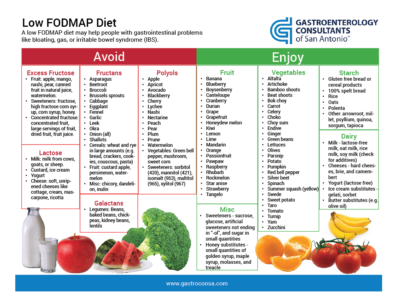Can Eat Beef and Pork With Ibs
Patient Education
Low FODMAP Diet
Many people with digestive symptoms find that certain foods seem to trigger those symptoms. It's sometimes a long process of trial and error to pinpoint precisely which foods are the triggers.
Researchers discovered that our digestive enzymes can't break down certain types of carbohydrates – starches, sugars, and fibers in food. Instead, the good bacteria in our gut ferment them. Avoiding foods that contain these carbohydrates and only eating low FODMAP foods may be the key to relieving uncomfortable symptoms triggered by certain foods.
For people with gastrointestinal problems like bloating, gas, or irritable bowel syndrome (IBS) – a low FODMAP diet may help. Some studies have shown that 3 out of 4 people with IBS saw fewer symptoms right away with the most relief after a week of eating a low FODMAP diet.
Some studies have shown that 3 out of 4 people with IBS saw fewer symptoms right away. They had the most relief after a week of eating a low FODMAP diet.
Low FODMAP Diet
What is a Low FODMAP Diet?
 A low FODMAP diet restricts certain carbohydrates, but this isn't the typical low-carb diet. It only eliminates high FODMAP foods and can be individualized, so you only restrict those that trigger your symptoms.
A low FODMAP diet restricts certain carbohydrates, but this isn't the typical low-carb diet. It only eliminates high FODMAP foods and can be individualized, so you only restrict those that trigger your symptoms.
FODMAP stands for "Fermentable Oligosaccharides, Disaccharides, Monosaccharides And Polyols."
Most people don't have problems when eating FODMAPs, but for some people they can cause cramping, bloating, gas, or diarrhea.
FODMAPs are a problem for some people because they draw more fluid into the intestine and create more gas. They create more gas because they are more easily fermented in the gut. The combination of additional fluid and increased gas can slow digestion, resulting in gas, bloating, pain, or diarrhea.
How to Find FODMAP Food Triggers
Sometimes, diets that restrict the foods you eat can seem rigid or controlling. A low FODMAP diet is more about finding your food triggers than limiting you. You may only be sensitive to a few FODMAP carbs and, once you identify them, may continue to enjoy others without symptoms. Even after identifying your trigger foods, there are still many delicious and nutritious low FODMAP vegetables, fruits, proteins, nuts, grains, and even dairy foods.
Finding the foods that trigger your symptoms typically follows a three-step process. The first step involves eliminating all high FODMAP foods for several weeks. It's essential to work with a nutritionist, as it can be challenging to eliminate all high FODMAP carbs and identify triggers while still meeting your nutritional needs.
The three steps are:
- Elimination – In this first step, you eliminate all FODMAP carbs for several weeks. Your symptoms may improve immediately or over several weeks.
- Reintroduction – In this step, you'll introduce FODMAPs one at a time to identify which foods you can tolerate and in what amount.
- Personalization – Finally, you'll modify your diet to increase variety while adjusting the type and amount of FODMAP carbs you eat, based on what you learned in step 2.
Your nutritionist can help you move forward with your gut-friendly diet, answering questions, sharing low FODMAP recipes, and helping you plan healthy low FODMAP snacks.
High FODMAP carbs that you should avoid include:
- Fructose: Fruits (including apples, mangos, pears, watermelon), honey, high-fructose corn syrup, agave
- Lactose: Dairy (milk from cows, goats, or sheep), custard, yogurt, ice cream
- Fructans: Rye and Wheat, asparagus, broccoli, cabbage, onions, garlic
- Galactans: Legumes, such as beans (including baked beans), lentils, chickpeas, and soybeans
- Polyols: Sugar alcohols and fruits that have pits or seeds, such as apples, apricots, avocados, cherries, figs, peaches, pears, or plums
Low FODMAP foods to enjoy instead include:
- Dairy: Almond milk, lactose-free milk, rice milk, coconut milk, lactose-free yogurt, and hard cheeses.
- Fruit: Bananas, blueberries, cantaloupe, grapefruit, honeydew, kiwi, lemon, lime, oranges, and strawberries.
- Vegetables: Bamboo shoots, bean sprouts, bok choy, carrots, chives, cucumbers, eggplant, ginger, lettuce, olives, parsnips, potatoes, spring onions, and turnips.
- Protein: Beef, pork, chicken, fish, eggs, and tofu.
- Nuts/seeds: (limit to 10-15 each) Almonds, macadamia nuts, peanuts, pine nuts, and walnuts.
- Grain: Oats, oat bran, rice bran, gluten-free pasta, quinoa, white rice, and corn flour.
If you'd like professional advice on how to best adopt a low FODMAP diet that still meets your nutrition needs, schedule an appointment with our nutritionist.
Request Appointment
FAQs
What is FODMAP?
FODMAP is short for Fermentable Oligo-, Di-, Mono-Saccharides And Polyols, the scientific names for certain groups of carbs known to trigger gastrointestinal symptoms.
Is corn low FODMAP?
Corn is a low FODMAP vegetable. High-fructose corn syrup is not FODMAP because of the large amount of fructose it contains.
Is peanut butter low FODMAP?
Peanuts are low in FODMAPs, and natural peanut butter is also. Some peanut butter brands add sweeteners with FODMAPs, but typically add small amounts that most people tolerate.
keatingfrenjudipt.blogspot.com
Source: https://www.gastroconsa.com/patient-education/irritable-bowel-syndrome/low-fodmap-diet/
Posting Komentar untuk "Can Eat Beef and Pork With Ibs"